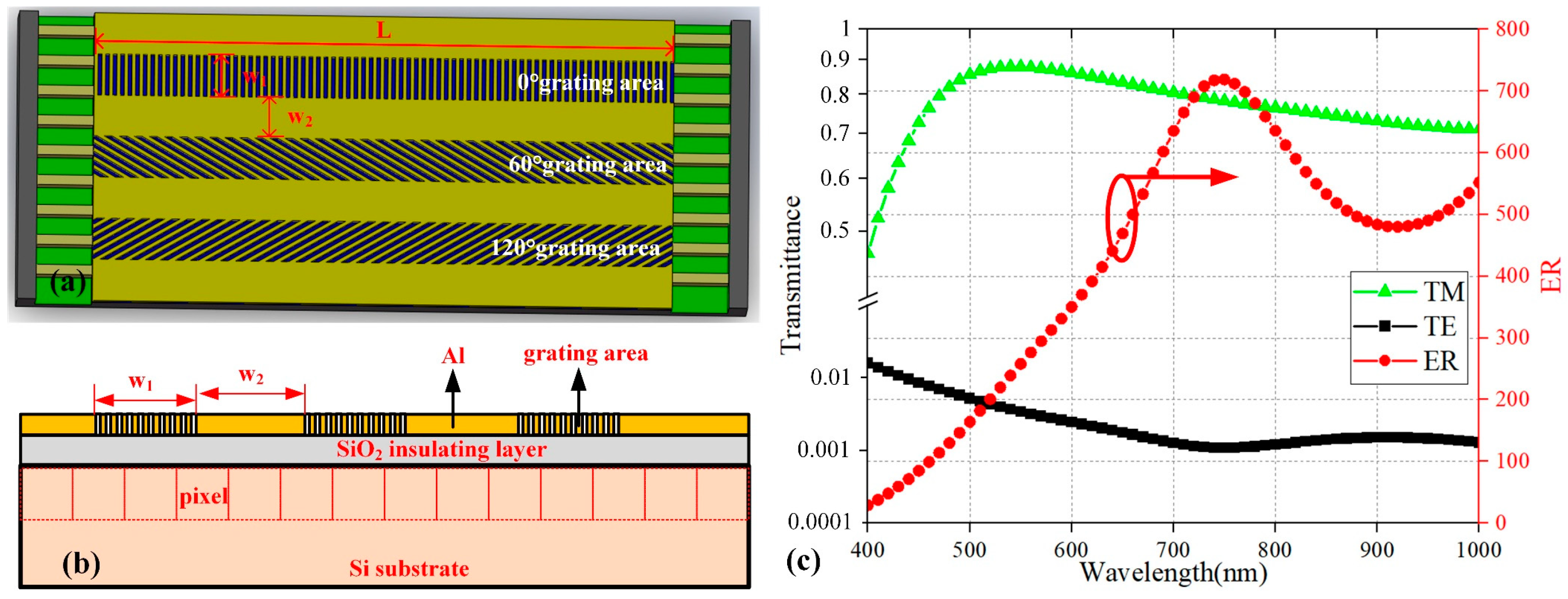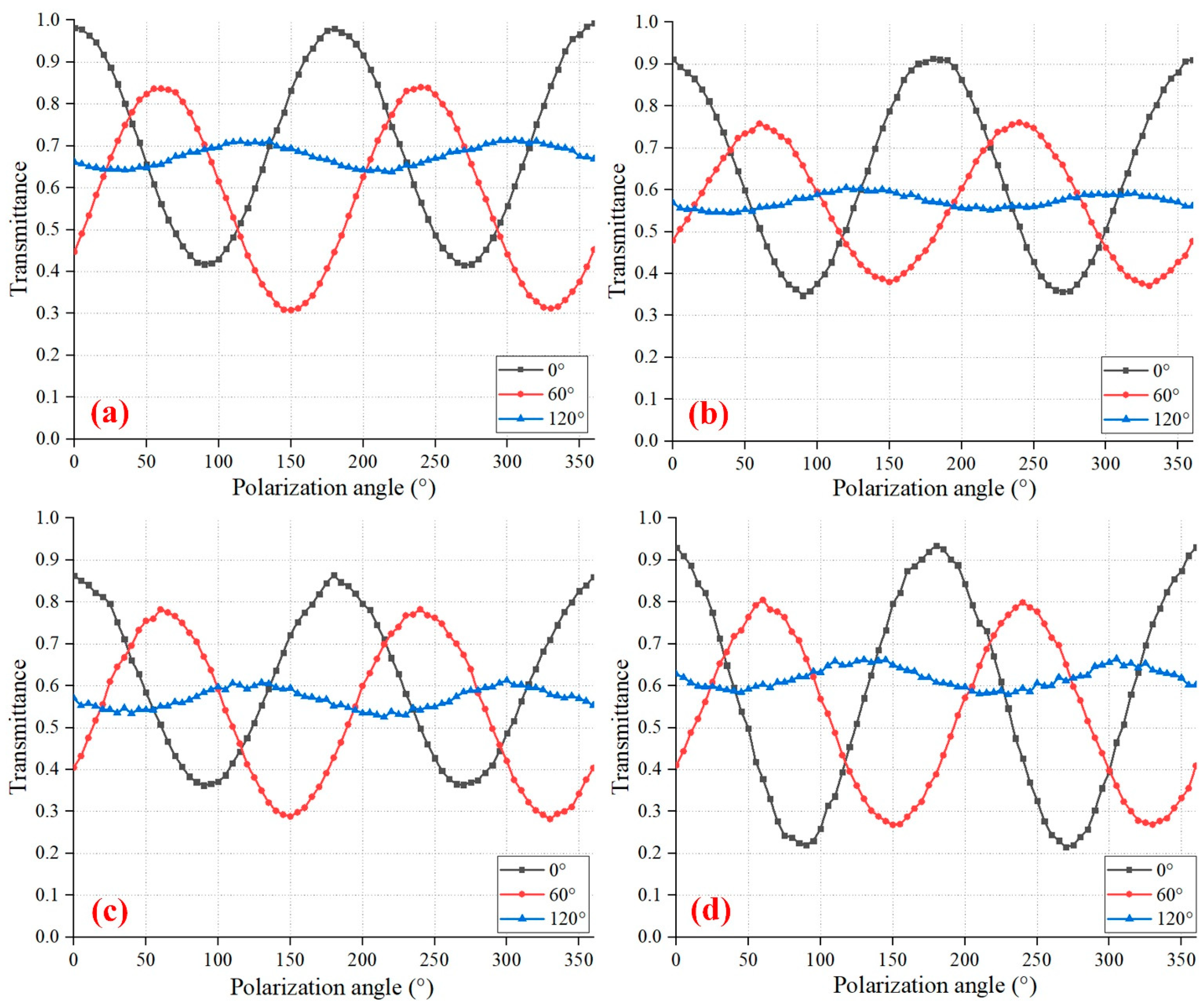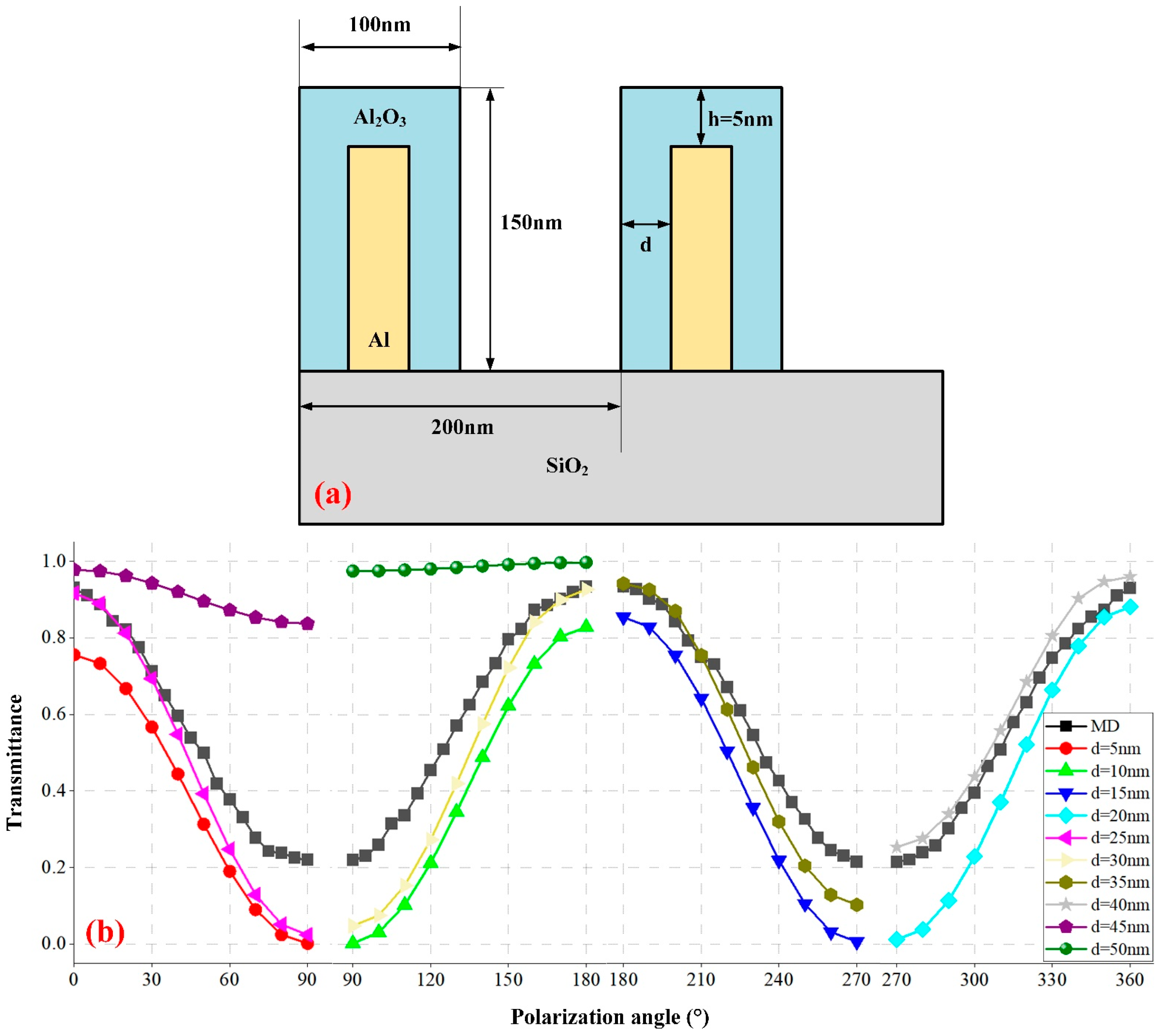Method of Directly Writing MPA on Photosensitive Surface of Detector Based on FIB
Abstract
:1. Introduction
2. Sensor Construction and Fabrication Method
2.1. Sensor Construction
2.2. Fabrication Method
3. Performance Measurement
3.1. Radiometric Calibration
3.2. Polarizing Performance
3.3. Crosstalk Measurement
4. Characterization Results and Discussion
5. Conclusions
Author Contributions
Funding
Institutional Review Board Statement
Informed Consent Statement
Data Availability Statement
Conflicts of Interest
References
- Muheim, R. Behavioural and physiological mechanisms of polarized light sensitivity in birds. Philos. Trans. R. Soc. B Biol. Sci. 2011, 366, 763–771. [Google Scholar] [CrossRef] [PubMed]
- Marshall, N.J. A unique colour and polarization vision system in mantis shrimps. Nature 1988, 333, 557–560. [Google Scholar] [CrossRef] [PubMed]
- Zhang, H.; Wu, Q.; Berezin, M.Y. Fluorescence anisotropy (polarization): From drug screening to precision medicine. Expert Opin. Drug Discov. 2015, 10, 1145–1161. [Google Scholar] [CrossRef] [PubMed]
- Namer, E.; Shwartz, S.; Schechner, Y.Y. Skyless polarimetric calibration and visibility enhancement. Opt. Express 2009, 17, 472–493. [Google Scholar] [CrossRef] [PubMed]
- Wang, D.; Liang, H.; Zhu, H.; Zhang, S. A Bionic Camera-Based Polarization Navigation Sensor. Sensors 2014, 14, 13006–13023. [Google Scholar] [CrossRef] [PubMed]
- Li, Z.; Hou, W.; Hong, J.; Fan, C.; Wei, Y.; Liu, Z.; Lei, X.; Qiao, Y.; Hasekamp, O.P.; Fu, G.; et al. The polarization crossfire (PCF) sensor suite focusing on satellite remote sensing of fine particulate matter PM2.5 from space. J. Quant. Spectrosc. Radiat. Transf. 2022, 286, 108217. [Google Scholar] [CrossRef]
- Shen, F.; Zhang, Q.; Ma, J.; Li, Z.; Hong, J. Identification of polluted clouds and composition analysis based on GF-5 DPC data. J. Quant. Spectrosc. Radiat. Transf. 2021, 269, 107659. [Google Scholar] [CrossRef]
- Deschamps, P.Y.; Breon, F.M.; Leroy, M.; Podaire, A.; Bricaud, A.; Buriez, J.C.; Seze, G. The POLDER mission: Instrument characteristics and scientific objectives. IEEE Trans. Geosci. Remote Sens. 1994, 32, 598–615. [Google Scholar] [CrossRef]
- Li, Z.; Xie, Y.; Hou, W.; Liu, Z.; Bai, Z.; Hong, J.; Ma, Y.; Huang, H.; Lei, X.; Sun, X.; et al. In-Orbit Test of the Polarized Scanning Atmospheric Corrector (PSAC) Onboard Chinese Environmental Protection and Disaster Monitoring Satellite Constellation HJ-2 A/B. IEEE Trans. Geosci. Remote Sens. 2022, 60, 4108217. [Google Scholar] [CrossRef]
- Brian, C.; Edgar, E.R.; Joseph, D.L.; Philip, M.W.T. Research scanning polarimeter and airborne usage for remote sensing of aerosols. In Polarization Science and Remote Sensing; SPIE: Bellingham, WA, USA, 2003; pp. 33–44. [Google Scholar]
- Bongkon, M.; Young-Jun, C.; Minsup, J.; Dae-Hee, L.; Youngsik, P.; Won-Kee, P.; Jakyoung, N.; Woojin, K.; Ji-Hye, S.; Sungsoo, S.K.; et al. Design of polarimeter payload for 12U CubeSat. In CubeSats and SmallSats for Remote Sensing IV; SPIE: Bellingham, WA, USA, 2020; p. 115050R. [Google Scholar]
- David, S.; Andrew, T. The Multi Angle Polarimeter (MAP) on board ESA’s Copernicus Carbon Dioxide Monitoring mission (CO2M). In International Conference on Space Optics—ICSO 2020; SPIE: Bellingham, WA, USA, 2021; p. 118520R. [Google Scholar]
- Wu, Z.; Powers, P.E.; Sarangan, A.M.; Zhan, Q. Optical characterization of wiregrid micropolarizers designed for infrared imaging polarimetry. Opt. Lett. 2008, 33, 1653–1655. [Google Scholar] [CrossRef]
- Cho, Y.T. Fabrication of wire grid polarizer for spectroscopy application: From ultraviolet to terahertz. Appl. Spectrosc. Rev. 2018, 53, 224–245. [Google Scholar] [CrossRef]
- Maruyama, Y.; Terada, T.; Yamazaki, T.; Uesaka, Y.; Nakamura, M.; Matoba, Y.; Komori, K.; Ohba, Y.; Arakawa, S.; Hirasawa, Y.; et al. 3.2-MP Back-Illuminated Polarization Image Sensor with Four-Directional Air-Gap Wire Grid and 2.5-μm Pixels. IEEE Trans. Electron. Devices 2018, 65, 2544–2551. [Google Scholar] [CrossRef]
- Sun, D.; Feng, B.; Yang, B.; Li, T.; Shao, X.; Li, X.; Chen, Y. Design and fabrication of an InGaAs focal plane array integrated with linear-array polarization grating. Opt. Lett. 2020, 45, 1559–1562. [Google Scholar] [CrossRef] [PubMed]
- Gruev, V.; Perkins, R.; York, T. CCD polarization imaging sensor with aluminum nanowire optical filters. Opt. Express 2010, 18, 19087–19094. [Google Scholar] [CrossRef] [PubMed]
- Zhang, Z.; Dong, F.; Cheng, T.; Qiu, K.; Zhang, Q.; Chu, W.; Wu, X. Nano-fabricated pixelated micropolarizer array for visible imaging polarimetry. Rev. Sci. Instrum. 2014, 85, 105002. [Google Scholar] [CrossRef] [PubMed]
- Nie, A.; Qiu, Z.; Sun, X.; Zhu, J.; Hong, J. Numerical study of a high-extinction-ratio micro-polarizer array with a metal grid substrate. Appl. Opt. 2022, 61, 9795–9800. [Google Scholar] [CrossRef]
- Guan, C.; Zhang, R.; Chu, J.; Liu, Z.; Fan, Y.; Liu, J.; Yi, Z. Integrated Real-Time Polarization Image Sensor Based on UV-NIL and Calibration Method. IEEE Sens. J. 2022, 22, 3157–3163. [Google Scholar] [CrossRef]
- Bassim, N.; Scott, K.; Giannuzzi, L.A. Recent advances in focused ion beam technology and applications. MRS Bull. 2014, 39, 317–325. [Google Scholar] [CrossRef]
- Tseng, A.A. Recent Developments in Nanofabrication Using Focused Ion Beams. Small 2005, 1, 924–939. [Google Scholar] [CrossRef]
- Available online: https://ams.com/documents/20143/4421878/CMV4000_DS000728_6-00.pdf (accessed on 13 July 2022).
- Meyer, L.; Vayugundla, M.; Kenny, P.; Smíšek, M.; Biele, J.; Maturilli, A.; Müller, M.G.; Stürzl, W.; Schuster, M.J.; Bodenmüller, T.; et al. Testing for the MMX Rover Autonomous Navigation Experiment on Phobos. In Proceedings of the 2023 IEEE Aerospace Conference, Big Sky, MT, USA, 4–11 March 2023; pp. 1–19. [Google Scholar]
- Wang, J.J.; Walters, F.; Liu, X.; Sciortino, P.; Deng, X. High-performance, large area, deep ultraviolet to infrared polarizers based on 40 nm line/78 nm space nanowire grids. Appl. Phys. Lett. 2007, 90, 061104. [Google Scholar] [CrossRef]
- Yao, D.; Liang, H.; Campos, J.; Yan, L.; Yan, C.; Jiang, C.; Tan, S.; Liang, C.; Wang, H.; Meng, L.; et al. Calculation and restoration of lost spatial information in division-of-focal-plane polarization remote sensing using polarization super-resolution technology. Int. J. Appl. Earth Obs. Geoinf. 2023, 116, 103155. [Google Scholar] [CrossRef]
- Chen, Z.; Wang, X.; Pacheco, S.; Liang, R. Impact of CCD camera SNR on polarimetric accuracy. Appl. Opt. 2014, 53, 7649–7656. [Google Scholar] [CrossRef] [PubMed]
- Wang, D.; Zhang, T.; Kuang, H. Relationship between the charge-coupled device signal-to-noise ratio and dynamic range with respect to the analog gain. Appl. Opt. 2012, 51, 7103–7114. [Google Scholar] [CrossRef] [PubMed]
- Powell, S.B.; Gruev, V. Calibration methods for division-of-focal-plane polarimeters. Opt. Express 2013, 21, 21039–21055. [Google Scholar] [CrossRef] [PubMed]
- Ye, Y.; Li, H.; Li, G.; Lin, L. A crosstalk correction method to improve multi-wavelength LEDs imaging quality based on color camera and frame accumulation. Signal Process. Image Commun. 2022, 102, 116624. [Google Scholar] [CrossRef]
- Deng, Y.-G.; Liu, J. Corrosion development between liquid gallium and four typical metal substrates used in chip cooling device. Appl. Phys. A 2009, 95, 907–915. [Google Scholar] [CrossRef]
- Cheng, F.; Su, P.-H.; Choi, J.; Gwo, S.; Li, X.; Shih, C.-K. Epitaxial Growth of Atomically Smooth Aluminum on Silicon and Its Intrinsic Optical Properties. ACS Nano 2016, 10, 9852–9860. [Google Scholar] [CrossRef]









Disclaimer/Publisher’s Note: The statements, opinions and data contained in all publications are solely those of the individual author(s) and contributor(s) and not of MDPI and/or the editor(s). MDPI and/or the editor(s) disclaim responsibility for any injury to people or property resulting from any ideas, methods, instructions or products referred to in the content. |
© 2024 by the authors. Licensee MDPI, Basel, Switzerland. This article is an open access article distributed under the terms and conditions of the Creative Commons Attribution (CC BY) license (https://creativecommons.org/licenses/by/4.0/).
Share and Cite
Nie, A.; Qiu, Z.; Sun, X.; Zhu, J.; Hong, J. Method of Directly Writing MPA on Photosensitive Surface of Detector Based on FIB. Sensors 2024, 24, 3769. https://doi.org/10.3390/s24123769
Nie A, Qiu Z, Sun X, Zhu J, Hong J. Method of Directly Writing MPA on Photosensitive Surface of Detector Based on FIB. Sensors. 2024; 24(12):3769. https://doi.org/10.3390/s24123769
Chicago/Turabian StyleNie, Anran, Zhenwei Qiu, Xiaobing Sun, Jun Zhu, and Jin Hong. 2024. "Method of Directly Writing MPA on Photosensitive Surface of Detector Based on FIB" Sensors 24, no. 12: 3769. https://doi.org/10.3390/s24123769



